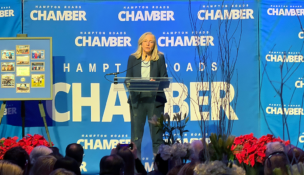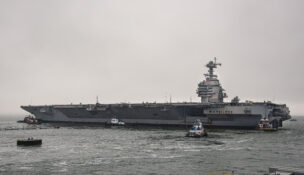Ways of the water
Program teaches coastal management skills
Beth JoJack //April 28, 2022//
Back in 2016, Virginia Coastal Zone Management program planners began talking about ways to protect the Lower Chickahominy River watershed.
“We’re like, ‘Well, let’s get ahead of this,’” says Jefferson Flood, an appropriately named coastal planner for the CZM, a network of individuals from Virginia agencies and local governments who work to protect coastal resources. “Let’s look at ways to promote ecotourism, promote zoning — empowering the localities to understand that they can make a lot of money off of ecotourism and that sort of thing, versus zoning for another shopping center.”
To get it done, Flood worked closely with a diverse group of stakeholders, including administrators in several counties, small business owners and leaders from the Chickahominy and the Pamunkey Indian tribes.
As he built those relationships, Flood found himself using strategies he learned in a class called Social Science Basics for Coastal Managers offered through the Coastal Training Program (CTP) of the Chesapeake Bay National Estuarine Research Reserve, which is managed by the Virginia Institute of Marine Science. The class tackled topics such as engaging interested parties, conducting effective interviews and leading focus groups.
“The training helped me personally, but it also helped to grow the program,” Flood says of the CZM.
Flood’s efforts paid off. During the latter half of 2021, the CZM’s stakeholders signed a memorandum of understanding agreeing to collaborate on efforts to increase sustainable ecological and economic activity in the watershed.
Such a cooperative effort was a new approach for this type of environmental effort, according to Flood. “That had not been done before that we’re aware of anywhere in this region,” he says.
Safeguarding coastal resources
The National Estuarine Research Reserve System is a network of 30 coastal areas established through the 1972 Coastal Zone Management Act. Each reserve system employs staff charged with protecting and studying estuaries — bodies of water where rivers and streams meet the ocean.
Every reserve system offers a coastal training program to support coastal decision-makers such as local government and state agency officials, nonprofit administrators, and owners and employees of businesses involved with aquaculture operations, recreation outfitters and construction.
Virginia’s program, which launched in 2001, offers training on a wide variety of topics, from habitat restoration to tribal engagement for localities. It also works to provide technical assistance, helping with tasks like collaborative research and designing surveys.
“This program has historically been known for more … in-person, kind of hands-on field experiences,” says Cirse Gonzalez, coastal training program coordinator for the Chesapeake Bay National Estuarine Research Reserve. “I’ve scaled back on the courses and the training a lot just to focus on these other elements of the program, which involve a lot of community engagement.”
Last year, Gonzalez, who earned a master’s degree in marine affairs from the University of Washington, began offering office hours, allowing coastal decision-makers to schedule time to discuss everything from planning an effective coastal project to the latest science on sea-level rise.
Gonzalez’s openness to collaboration has been a professional boon for Taryn Sudol, coordinator for the Chesapeake Bay Sentinel Site Cooperative, which works to improve planning and management decisions regarding sea level rise.
“If I reach out to Cirse with a question,” Sudol says, “she’s often able to point me in the right direction or say, ‘Did you know about this research going on here or there?’”
Like a lot of offices, the Chesapeake Bay research reserve went virtual went the pandemic hit. “It’s all moved online … for better or worse,” Gonzalez says.
Even with the coastal trainings held remotely, Jessica Steelman appreciates how the courses give her an opportunity to collaborate with other folks in the field.
“You get a broad range of planners and project managers in a room talking about [topics like] equitable negotiation, and you’ve got ideas that you never would have thought of on your own,” says Steelman, a coastal planner with the Accomack-Northampton Planning District Commission.
As CTP coordinator from 2006 until her retirement in 2018, Sandra Erdle had the pre-pandemic luxury of offering trainings in the field. One of her most popular offerings was a course on wetland delineation, referring to determining the location and size of any wetlands on a property. Heads of environmental consulting firms would call Erdle to book seats in the class months in advance, she recalls.
As of March, the 2022 slate of courses — including a wetland delineation course, which hasn’t been offered since before the pandemic — was still in planning stages.
“I’m really looking forward to seeing people again and getting out in the field myself,” Gonzalez says.

















